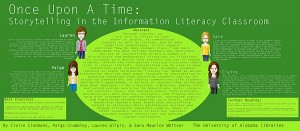By the end of the semester, I’d learned how to plan effective information literacy sessions. What I had not expected to learn was how much I enjoyed seeing students actually get what I was saying. Freshman aren’t always the easiest bunch of people to teach. They come from so many different backgrounds and they are entirely new to the college game–they have to write different, begin thinking more critically, and think about the direction they want to go in for the rest of their college career. Researching is a big part of that, and for them to finally have it all click and look relieved that it was one less thing off their shoulders, it was a huge win for me. When one of them told me that they loved one of the activities I had them do in class, I fist pumped so hard after class that I nearly pulled a muscle–because to learn, you don’t necessarily have to enjoy something. But having that extra little encouragement made me believe that I was making a difference.
Me? A Teacher? I could be. What kind of teacher? One who wants to connect with students and let them connect with the information by using stories and interesting things that reveal research as something that could be interesting and fun, not just something they had to do. It’s hard to achieve in the information literacy classroom, but the simple engagement of their minds with stories, interesting sources, and pop culture could enable me to interact with the information they grab from the internet instead of just using it and discarding it. Each source has the potential to teach them something and inform them about a topic they find interesting… allowing them to see that research as something engaging and intriguing would be my job as a library instruction teacher.
